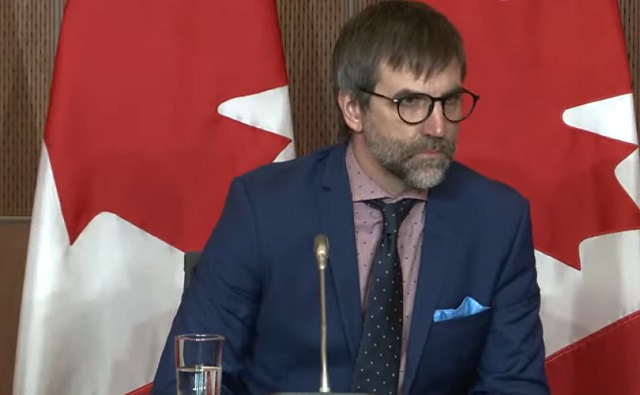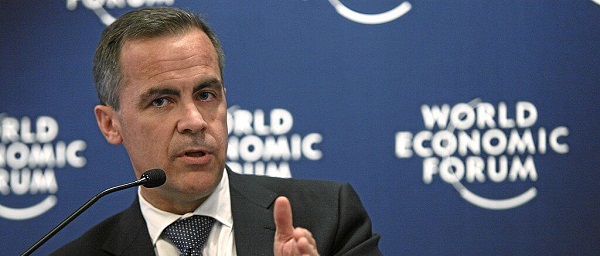Energy
Stop The Cap On Oil And Gas

From Project Confederation
With the United Nations’s 28th Climate Change Conference in Dubai generating headlines, we all knew it was only a matter of time before Canada’s radical eco-activist Environment Minister did something stupid.
And here it is, from Steven Guilbeault himself:
“The Government of Canada’s plan to cap and reduce emissions from Canada’s largest emitting sector is ambitious, but practical. It considers the global demand for oil and gas — and the importance of the sector in Canada’s economy — and sets a limit that is strict, but achievable.”
That’s right, folks – the Oil and Gas emissions/production cap is finally upon us.
We launched a campaign last year, around this same time, warning that this was coming.
Now, we know just how bad it actually is.
If you already agree that we should Stop The Cap On Oil And Gas,
click here to sign the petition, but if you want more details, read on!
The framework that’s being proposed by the federal government would cap emissions at 35% – 38% below 2019 levels.
How exactly would this be done?
What will it cost?
No one knows.
The federal government just says that they’ll release the details via regulation sometime next year.
Alberta Premier Danielle Smith is livid, issuing a statement:
“[The announcement is an] intentional attack by the federal government on the economy of Alberta and the financial well-being of millions of Albertans and Canadians.”
“Justin Trudeau and his eco-extremist Minister of the Environment and Climate Change, Steven Guilbeault, are risking hundreds of billions of investments in Alberta’s and Canada’s economy.”
Saskatchewan Premier Scott Moe echoed Smith:
“[The cap] will have serious economic impacts on Canadians and limit our sustainable Canadian energy products from providing heat and electricity to the world.”
“Saskatchewan will protect our constitutional right to build our economy in accordance with the priorities of Saskatchewan families and businesses.”
The federal government has been in legal hot water lately over constitutional overreaches – with the Supreme Court deeming the Impact Assessment Act unconstitutional in October and the Federal Court ruling the plastics ban unconstitutional in November.
Ottawa has consistently ignored provincial jurisdiction on a wide range of issues, and their inability to stay in their constitutional lane has been a major source of tension with the provinces.
This emissions cap is just the latest example, as natural resource development is guaranteed to be the sole jurisdiction of the provinces in the Constitution of Canada.
As such, the emissions cap is clearly unconstitutional – but even if it wasn’t, it would be a terrible policy anyway.
First, it’s an admission by the government that the carbon tax – their signature climate change policy – is not working.
The entire purpose of the tax was to be a “market mechanism” to reduce emissions, and yet now they’re admitting that they need even more regulations to reduce emissions.
This cap is a direct and deliberate attack on western Canada’s oil and gas industry.
Remember – the cap will not apply to any industry other than oil and gas.
Ontario’s automotive industry, Quebec’s cement industry, and other high-emitting industries in other parts of Canada are not having their emissions capped.
The cap also excludes refineries – even though that is part of the oil and gas industry – because many of Canada’s refineries happen to be in regions of the country that mostly vote Liberal.
If the federal government were actually concerned about the environment, they would implement policies designed to reduce emissions across all industries and all regions of Canada.
Instead, the hypocritical and political nature of Ottawa’s climate agenda reveals their true intentions and undermines the credibility of their entire plan.
That’s why we’re renewing our campaign calling on the federal government to back off, respect the Constitution, and stop infringing on provincial jurisdiction.
If you agree, please sign our petition to Stop The Cap On Oil And Gas:
Josh Andrus
Executive Director
Project Confederation
Energy
China undermining American energy independence, report says

From The Center Square
By
The Chinese Communist Party is exploiting the left’s green energy movement to hurt American energy independence, according to a new report from State Armor.
Michael Lucci, founder and CEO of State Armor, says the report shows how Energy Foundation China funds green energy initiatives that make America more reliant on China, especially on technology with known vulnerabilities.
“Our report exposes how Energy Foundation China functions not as an independent nonprofit, but as a vehicle advancing the strategic interests of the Chinese Communist Party by funding U.S. green energy initiatives to shift American supply chains toward Beijing and undermine our energy security,” Lucci said in a statement before the Senate Judiciary Subcommittee’s hearing on Wednesday titled “Enter the Dragon – China and the Left’s Lawfare Against American Energy Dominance.”
Lucci said the group’s operations represent a textbook example of Chinese influence in America.
“This is a very good example of how the Chinese Communist Party operates influence operations within the United States. I would actually describe it as a perfect case study from their perspective,” he told The Center Square in a phone interview. “They’re using American money to leverage American policy changes that make the American energy grid dependent upon China.”
Lucci said one of the most concerning findings is that China-backed technology entering the U.S. power grid includes components with “undisclosed back doors” – posing a direct threat to the power grid.
“These are not actually green tech technologies. They’re red technologies,” he said. “We are finding – and this is open-source news reporting – they have undisclosed back doors in them. They’re described in a Reuters article as rogue communication devices… another way to describe that is kill switches.”
Lucci said China exploits American political divisions on energy policy to insert these technologies under the guise of environmental progress.
“Yes, and it’s very crafty,” he said. “We are not addressing the fact that these green technologies are red. Technologies controlled by the Communist Party of China should be out of the question.”
Although Lucci sees a future for carbon-free energy sources in the United States – particularly nuclear and solar energy – he doesn’t think the country should use technology from a foreign adversary to do it.
“It cannot be Chinese solar inverters that are reported in Reuters six weeks ago as having undisclosed back doors,” he said. “It cannot be Chinese batteries going into the grid … that allow them to sabotage our grid.”
Lucci said energy is a national security issue, and the United States is in a far better position to achieve energy independence than China.
“We are luckily endowed with energy independence if we choose to have it. China is not endowed with that luxury,” he said. “They’re poor in natural resources. We’re very well endowed – one of the best – with natural resources for energy production.”
He said that’s why China continues to build coal plants – and some of that coal comes from Australia – while pushing the United States to use solar energy.
“It’s very foolish of us to just make ourselves dependent on their technologies that we don’t need, and which are coming with embedded back doors that give them actual control over our energy grid,” he said.
Lucci says lawmakers at both the state and federal levels need to respond to this threat quickly.
“The executive branch should look at whether Energy Foundation China is operating as an unregistered foreign agent,” he said. “State attorneys general should be looking at these back doors that are going into our power grid – undisclosed back doors. That’s consumer fraud. That’s a deceptive trade practice.”
Energy
Carney’s Bill C-5 will likely make things worse—not better

From the Fraser Institute
By Niels Veldhuis and Jason Clemens
The Carney government’s signature legislation in its first post-election session of Parliament—Bill C-5, known as the Building Canada Act—recently passed the Senate for final approval, and is now law. It gives the government unprecedented powers and will likely make Canada even less attractive to investment than it is now, making a bad situation even worse.
Over the past 10 years, Canada has increasingly become known as a country that is un-investable, where it’s nearly impossible to get large and important projects, from pipelines to mines, approved. Even simple single-site redevelopment projects can take a decade to receive rezoning approval. It’s one of the primary reasons why Canada has experienced a mass exodus of investment capital, some $387 billion from 2015 to 2023. And from 2014 to 2023, the latest year of comparable data, investment per worker (excluding residential construction and adjusted for inflation) dropped by 19.3 per cent, from $20,310 to $16,386 (in 2017 dollars).
In theory, Bill C-5 will help speed up the approval process for projects deemed to be in the “national interest.” But the cabinet (and in practical terms, the prime minister) will determine the “national interest,” not the private sector. The bill also allows the cabinet to override existing laws, regulations and guidelines to facilitate investment and the building of projects such as pipelines, mines and power transmission lines. At a time when Canada is known for not being able to get large projects done, many are applauding this new approach, and indeed the bill passed with the support of the Opposition Conservatives.
But basically, it will allow the cabinet to go around nearly every existing hurdle impeding or preventing large project developments, and the list of hurdles is extensive: Bill C-69 (which governs the approval process for large infrastructure projects including pipelines), Bill C-48 (which effectively bans oil tankers off the west coast), the federal cap on greenhouse gas emissions for only the oil and gas sector (which effectively means a cap or even reductions in production), a quasi carbon tax on fuel (called the Clean Fuels Standard), and so on.
Bill C-5 will not change any of these problematic laws and regulations. It simply will allow the cabinet to choose when and where they’re applied. This is cronyism at its worst and opens up the Carney government to significant risks of favouritism and even corruption.
Consider firms interested in pursuing large projects. If the bill becomes the law of the land, there won’t be a new, better and more transparent process to follow that improves the general economic environment for all entrepreneurs and businesses. Instead, there will be a cabinet (i.e. politicians) with new extraordinary powers that firms can lobby to convince that their project is in the “national interest.”
Indeed, according to some reports, some senators are referring to Bill C-5 as the “trust me” law, meaning that because there aren’t enough details and guardrails within the legislation, senators who vote in favour are effectively “trusting” Prime Minister Carney and his cabinet to do the right thing, effectively and consistently over time.
Consider the ambiguity in the legislation and how it empowers discretionary decisions by the cabinet. According to the legislation, cabinet “may consider any factor” it “considers relevant, including the extent to which the project can… strengthen Canada’s autonomy, resilience and security” or “provide economic benefits to Canada” or “advance the interests of Indigenous peoples” or “contribute to clean growth and to meeting Canada’s objectives with respect to climate change.”
With this type of “criteria,” nearly anything cabinet or the prime minister can dream up could be deemed in the “national interest” and therefore provide the prime minister with unprecedented and near unilateral powers.
In the preamble to the legislation, the government said it wants an accelerated approval process, which “enhances regulatory certainty and investor confidence.” In all likelihood, Bill C-5 will do the opposite. It will put more power in the hands of a very few in government, lead to cronyism, risks outright corruption, and make Canada even less attractive to investment.
-

 Automotive1 day ago
Automotive1 day agoElectric vehicle sales are falling hard in BC, and it is time to recognize reality.
-

 Alberta6 hours ago
Alberta6 hours agoAlberta Independence Seekers Take First Step: Citizen Initiative Application Approved, Notice of Initiative Petition Issued
-

 Automotive1 day ago
Automotive1 day agoPower Struggle: Electric vehicles and reality
-

 Business1 day ago
Business1 day agoTrump on Canada tariff deadline: ‘We can do whatever we want’
-

 Business8 hours ago
Business8 hours agoCanada Caves: Carney ditches digital services tax after criticism from Trump
-

 Brownstone Institute2 days ago
Brownstone Institute2 days agoFDA Exposed: Hundreds of Drugs Approved without Proof They Work
-

 Crime8 hours ago
Crime8 hours agoSuspected ambush leaves two firefighters dead in Idaho
-

 Energy1 day ago
Energy1 day agoChina undermining American energy independence, report says



